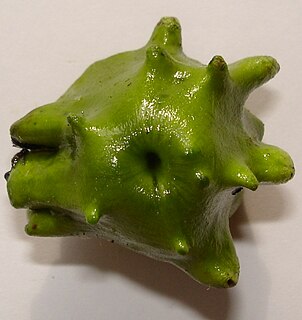
Gall wasps, also called gallflies, are a family (Cynipidae) in the wasp superfamily Cynipoidea within the suborder Apocrita of the order Hymenoptera. Their common name comes from the galls they induce on plants for larval development. About 1300 species of this generally very small creature (1–8 mm) are known worldwide, with about 360 species of 36 different genera in Europe and some 800 species in North America.

Andricus quercuscalicis is a gall wasp species inducing knopper galls.

Andricus is a genus of gall wasps in the family Cynipidae, comprising the following species:

Andricus grossulariae is a gall wasp species inducing agamic acorn cup galls on oak tree acorn cups and sexual phase galls on catkins. Synonyms include Andricus fructuum, Andricus gemellus, Andricus intermedius, Andricus mayri and Cynips panteli.

Cynipini is a tribe of gall wasps. These insects induce galls in plants of the beech and oak family, Fagaceae. They are known commonly as the oak gall wasps.

Andricus quercuscalifornicus, or the California gall wasp, is a small wasp species that induces oak apple galls on white oaks, primarily the Valley Oak but also other species such as Quercus berberidifolia. It is found from Washington, Oregon, and California to northern regions of Mexico. Often multiple wasps in different life stages occupy the same gall.

Andricus aries is a species of gall-forming wasps, in the genus Andricus. The species was named by the French entomologist Joseph-Étienne Giraud, in 1859. It is commonly found in eastern Europe and during the 21st century has spread to western Europe.
Pseudoneuroterus nichollsi is a gall wasp species in the family Cynipidae whose life cycle involves only Palaearctic oaks, Quercus subgen. Quercus, in the section Cerris.
Pseudoneuroterus mazandarani is a gall wasp species in the family Cynipidae whose life cycle involves only Palaearctic oaks, Quercus subgen. Quercus, in the section Cerris.
Dryocosmus jungalii is a gall wasp species in the family Cynipidae whose life cycle involves only Palaearctic oaks, Quercus subgen. Quercus, in the section Cerris.

Trichagalma formosana is a gall wasp species in the family Cynipidae whose life cycle involves only Palaearctic oaks, Quercus subgen. Quercus, in the section Cerris. It is endemic to Taiwan.
Aphelonyx kordestanica is a gall wasp species in the family Cynipidae whose life cycle involves only Palaearctic oaks, Quercus subgen. Quercus, in the section Cerris.
Aphelonyx is a genus of gall wasps in the family Cynipidae, comprising three known species:
Andricus opertus, the fimbriate gall wasp, is a species of wasp in the family Cynipidae whose bisexual generation induces elongate, spiky galls on the leaves of various species of oaks in California, including valley oak and scrub oak. The galls of the bisexual generation form in spring, adults emerge in late spring, and galls persist on trees until the fall. The unisexual generation of this species forms aborted bud galls in the summer and fall.
Bassettia is a genus of gall wasps found in North America.
Bassettia pallida is a species of gall wasp found in the Southern United States. This species was described by American entomologist William Harris Ashmead in 1896. B. pallida reproduces asexually in galls it induces on oak trees. The parasite Euderus set, a chalcid wasp, has B. pallida as a host and manipulates its behavior.
Andricus quercusfoliatus, the leafy oak gall wasp, is a species of gall wasp in the family Cynipidae.
Synergini is a tribe of tropical gall wasps in the subfamily Cynipinae.
Heteroecus is a genus of gall wasps in the family Cynipidae. There are about seven described species in Heteroecus.

Andricus curvator is a gall wasp which forms chemically induced leaf galls on oak trees and has both agamic and sexual generations. Agamic and sexual generations usually form two distinct galls on oak trees, but in the case of A. curvator there are six galls; the sexual generation usually on the leaf, occasionally in a twig or catkin, and the agamic generation in a bud. The wasp was first described by Theodor Hartig, a German biologist, in 1840 and is found in most of Europe.










